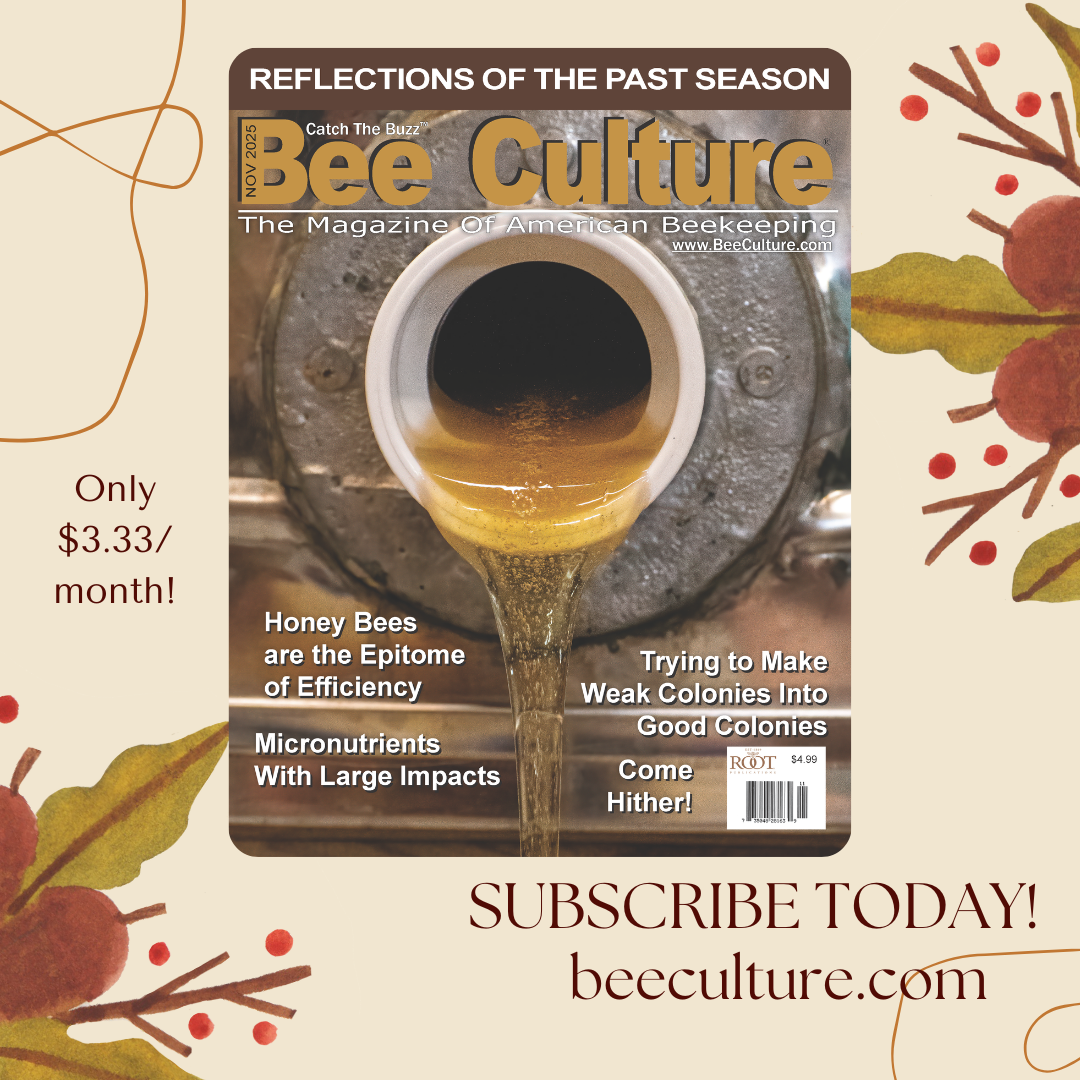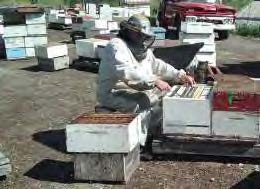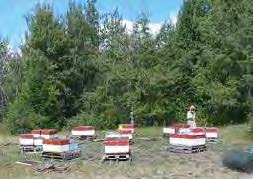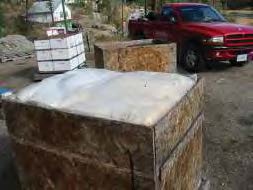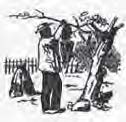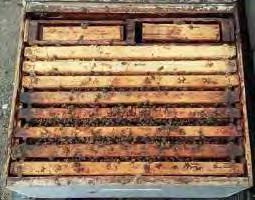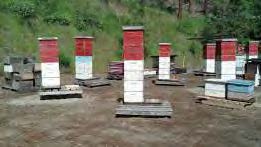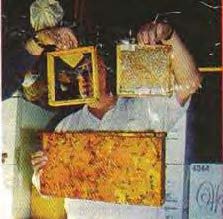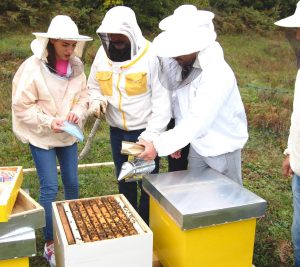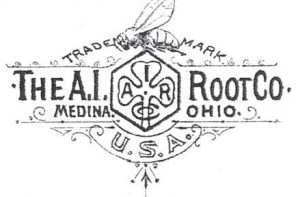By : Bill Ruzicka
PACKAGES, NUCS, SPLITS, AND SWARMS were created for traditional northern beekeeping when the bees were gassed and killed after the first frost in late August or early September. All of the honey was extracted and the combs were sorted and prepared for spring packages bought from California. This practice was all based on having fully drawn comb not using foundation.
NEW BEES: Someone forgot to tell you that packages, splits, nucs, and swarms in dry areas need to be placed in fully drawn comb. The bees will not continue to draw out foundation when the honey flow ends in mid July. You should be buying bees on fully drawn combs to be successful. (See lesson 6) It takes an astonishing seven to eight lbs of honey to create 1 lb of wax.
BUYERS AND SELLERS: Make sure the donor colonies are treated a month before sales with low dose continuous release formic acid treatment by MiteGone. It not only cleans the donor hive from both mites but also prevents reinfestation.
ARTIFICIAL SWARMS are the best way to replace any bees that you lost or as a way to increase the amount of hives you have. A full size colony will produce a full or better crop in the summer when placed into DRAWN DEEP COMB WITH STORES. This process of artificial swarms eliminates the transfer of diseases like AFB. You are getting an established over-wintered laying queen and bees.
There is no transfer of equipment, only bees. The queen is laying 2000 eggs a day and will not stop. She must be transferred onto nice clean drawn comb to continue to lay and within three days she will have laid three frames of brood. I will explain how it is all done in lesson 5, a section called ARTIFICIAL SWARMS.
In the late 70s, I bought a 100 hive outfit and went through all the normal sources of acquiring bees. The operation had only 20 live colonies and a lot of old equipment of various sizes. Imagine that each bottom board had its own entrance reducer; all reducers were a different length. You simply sat in front of each hive and tried them until one fit. This type of beekeeping did not mesh with my upbringing and education. Therefore, over the Summer and Winter I sorted everything and standardized and fixed what was usable. On the advice from Leo Fuhr, I requeened all 20 colonies and ensured they were well fed and stocked for winter to ensure that I would be able to do a lot of splits in the spring.
Lesson 1 – Splits and Hive Arrangements
I wintered all 20 colonies in two rows side to side and back to back. Each colony was two supers high and I winterized all the hives everything in one gigantic Winter wrap of insulation and black paper. This arrangement taught me a lesson in drifting.
In the Spring, the end hives were booming and the center hives were very weak needing a lot of boosting. Therefore in the Spring, we changed the hive configuration into groups of four arranged in a circle to prevent drifting, like above. By late May we were able to split them into 50 honey producing hives.
Lesson Learned: I adapted this model to all my yards as it eliminates drifting.
Lesson 2 – Packages and Equipment –
This was in the late 70s when packages were typical in northern beekeeping in Canada and U.S. Everybody in the north after first frost in late August gassed their bees, extracted all the honey and sorted their equipment to receive packages in Spring. Each year Ernie Fuhr took his truck in late March and went to California to buy 2500 packages. 2000 for him and 500 to sell. He always stopped at his parent’s place in Vernon. That is where I got my first 50 packages and installed them on well prepared boxes with drawn comb and gallon feeders full of feed on top. They took off nicely and produced honey.
Therefore, I decided to do the same thing the following year but I did not have enough drawn comb. I did have a lot of new foundation that I had made over the Winter. I fed the hives the same way as I had done in the past and then relied on honey flow for the hives to build. By mid August, the hives should have been booming but instead the bees confined themselves to the four to five drawn frames I had given them. That is when I learned that it takes seven lbs of honey to create one lb of wax. Doing a lot of feeding from mid-August until the end of September brought them up to six to eight frames of bees. I created an inner feeder and set these small hives on top of my stronger two high colonies for the Winter. I packed them in four packs made of plywood and 1” corolite walls and 3½” fi berglass insulation in plastic bags on top to Winter. I learned how to Winter small colonies and how much it cost to draw foundation.
Lesson Learned: Do not put the packages on foundation only unless YOU provide plenty of heavy feed. 64% Heavy feed doesn’t crystallize or ferment.
Heavy syrup is 16 kg sugar into 20 liters of finished syrup (not into 20 liters of water) or 35 lbs of sugar into 10 ½ US gallons of finished syrup (not into 10½ U.S. gallons of water). To mix heavy syrup, mark (draw a line) on a large mixing container at 20 liters or 10½ gallons. Fill this container to about half with hot water and then add the measured sugar mixing as you add. Then top off the mixture with hot water to your mark (line).
Lesson 3 – Nucs
I did my share of nucing when I was reducing my operation from 500 hives to 280. It was a nice way to sell surplus equipment. But in the late 80s when the first mites came and borders were closed, the BC bee breeding industry started to form. In my accounting mind, I could not justify making and selling nucs. Why?
In the Central Okanagan, in the bush on non-irrigated lands, to make and draw a perfect brood frame, cost me at that time, $10. Therefore four frames would cost $40. Selling nukes at that time for $45 did not make much sense to me. As a result, I developed the practice of selling artificial swarms. We will return to them in lesson 5.
But now back to nucs. If you are just starting with all new equipment and foundation, in areas with honey flow throughout the Summer, you forfeit any honey production and need to be prepared to provide the bees plenty of 64% heavy feed. Next you have to find a reliable source of bees. Talk to beekeepers and ask many questions. Do not buy a four-frame nuc on anything other than deep frames.
NUCS: THREE FRAMES IN APRIL OR FOUR FRAMES IN LATE MAY.
A-Indisputably the best are nucs made after pollination from over-wintered hives with queens reared in June the previous year. With proper feeding or a reliable honey flow they will draw foundation and produce honey for Winter.
B-Nucs With New Queens are quite common and work; however, they are a little slower in their development as young queens may require more time to swing into full production. Some queens may fail, but those who survive the Summer and are full size colonies in August, with proper treatments, like Formic, sufficient Winter stores, and Winter packing, will be good for the following year.
C- Nucs With Early Mated Queens are also common but may be badly mated. The reason for this is that there are not enough mature drones in April or early May. I tried for several years to run two-queen colonies. I would create extra units on top of the standard hive. Only in the first year did I have 140 mated queens out of 200 by mid May. This miracle never happened again and some queens ran out of sperm and became drone layers. This may happen in both B & C options. Always ask your supplier if he will replace queens if they fail by mid July.
D- Nucs By Mid July Are Called Splits. They are usually well developed units with reliable Queens. They will build up to strong winter colonies and produce honey well in the next two years. They will require re-queening in the second summer by proven queens reared in June.
Lesson 4 – Natural SWARMS
These are a great way to increase your numbers. And YES, the SWARM will do what all swarms do, build a new home and draw out comb. You just have to provide plenty of 64% heavy feed
The Queen has prepared herself for the swarm flight by reducing the amount of eggs she lays for several days until she stops entirely. She can wait until her worker bees build a new house with fully drawn comb to start laying again. On the day of swarming, the bees have gorged themselves on honey and then on a nice afternoon they are off to find new home. Any three cubic feet of space will do for the bees. This can be a chimney, under stairs, an old car, or box. How to catch them will be another lesson. What I have described above does not happen with Artificial Swarms.
LESSON 5 – ARTIFICIAL SWARMS
Artificial swarms are a better way to replace bees you lost or as a way to increase your numbers. You are getting a full size colony which will produce a full honey crop in the summer when installed into DRAWN DEEP COMB WITH STORES. This process eliminates the transfer of diseases like AFB. It has an over wintered queen with bees. There is no transfer of equipment, only bees.
The queen is laying 2000 eggs a day and will not stop. She must be transferred onto a nice clean drawn comb to continue lay. Within three days she will have laid three frames of brood and have five frames of bees. They will make the remaining 10 combs ready for her. This way you can start your beekeeping in late May, when there is a honey flow. Within seven days after you pick up your swarm, you will need to add second box.
ATTENTION: The difference between the artificial swarm and an actual swarm is that neither the bees nor the queen has time to prepare for swarming. The bees do not gorge themselves on honey. The queen is laying eggs at a rate of 2000 a day. That’s about one egg every 43 seconds. It will damage the queen if she does not have nice cells in which to lay eggs. On the other hand, if you give her quality combs you will have three frames of brood in three days. The hive will also need a lot of food at this point. You need to provide plenty of 64% heavy feed.
HOW WE DO IT
First, we work with our customers to prepare the SWARM box correctly. Swarms can be put into any sized equipment but inner feeders fi t only in deep boxes.
In the picture, you can see my two frame feeder with a capacity of four liters. These feeders are 40 years old and made of wood. This feeder can also be moved into the center of the box and divide the hive into two mating nucs. Now you can easily buy two frame plastic feeders. Put one such feeder against the side of the box. Then two outside combs (the one next to the feeder and the one next to the outside wall) should be honey combs. Next to them should be a frame of pollen each. That leaves you with space in middle of the box for four of your nicest frames that are ready to receive eggs and bees. The better you prepare this box, the better results you will have.
The bottom board is fastened to the swarm box so the unit can be carried around without it coming apart. The full size entrance must have a full size screen that is easily removable and installable.
The top of swarm box is covered with carpet or a potato sack and a telescoping top cover so it can be bee sealed for transport to the customer’s destination.
In April when we prepare two high hives for pollination standards we treated them with Oxalic. When they are back we put on Queen Excluder and brown honey box to stop them from natural swarming.
On a nice day in late May we remove our hive from where it is placed in the beeyard and put the prepared customer’s box in its place and open the screen. We find the queen and transfer it with all the bees onto customer’s comb into the customer’s box. We shake 60% of the bees from all of the combs into the customer’s box. In addition, the entire field force will return to the customer’s box by the end of the day. All of the combs that were shaken are placed on different hive to incubate. We usually stacked three hives worth of brood onto a fourth to incubate. Three days later, we check all of the customer’s swarms for a queen and eggs. Then one evening, the hives are loaded for transport.
All that is left behind are tall (five to six boxes high) incubators with brown honey boxes on top. We extract those and their dandelion honey after second shake so it does not crystallize in comb.
Ten days after the incubators were made they are shaken to produce a second round of swarms. These incubators are very strong colonies and in addition to making a second swarm, multiple three frame nucs are made from the residual brood and bees. These nucs receive a queen cell, mate Queens, and spend the Summer growing into next year’s colonies to pollinate and sell. Whole process starts again.
PERFORMANCE AND HISTORY
In 1988 we ran a 10 swarms test. In 1989, 100 swarms went to the Peace River area averaging seven pounds of bees each and they did great. In 1990, John Gates from the BC Apiculture Program ran tests and found Artificial Swarms a very workable system. The method was originally published in BeesCene in April 1991 and republished in 2013.
From 1991 to 1997 we produced 450-500 swarms each year for a variety of buyers. Most buyers wanted truck load quantities 80-150 or 200-250 for five ton trucks. Only in 1995 did we have a larger order 500. The customer had a class eight truck and semitrailer. It took the whole night to move his double bottom equipment from all the yards to the loading dock. Then a fork lift loaded the hives onto the trailer. It was 4:00 am and day light when this massive load left. I vowed that I would never do that again! Depending on year, the artificial swarms had on average 7.4-8.7 frames of bees and 2.9- 3.7 frames of brood three days after shaking.
In 1981 I decided to reduce my operation and sell the equipment in the form of four frame nucs. When I got down to 280 hives, we exchanged frames for many years with the PHILPOTS in Alberta and made 450 – four frame nukes into their prepared boxes.
In 2013, I reduced my operation further to 72 single colonies over wintered for pollination. With increasing problems with AFB, we were back to the method of Artificial Swarms which eliminates AFB transfer.
LESSON 6 – RETIRING AND SELLING FULL SIZE COLONIES
In 2018, at the age of 78, because of health reasons, I decided to sell my remaining 82 hives and operation in bits and pieces including the contracts. To those who are in same boat, I recommend it. Selling whole size colonies worked extremely well, and led to the creation of a . . .
. . . BEE BREEDER’S CIRCLE.
This group of local beekeepers will keep our local Vernon stock alive. We actually recreated the local Vernon stock improvement program where 20 of the best hives of the descendants of Vernon stock are brought into a breeding circle to produce nine queen cell builders and provide 18 graft combs of different mothers to produce future generations. I will mentor this group and have bees in my beeyard in Summer to play with.
For the benefit of the buyer and the seller I will do a cost benefit analysis of buying nucs and foundation against full size colony and income from it against selling the whole operation in 2018 prices. You can be the judge of what deal is better.
FULL SIZE COLONY that will produce honey – $400.00
Includes a standard deep box, top cover, bottom board, 10 fully drawn combs (including honey, pollen and approximately six combs of brood in various stages of development), our local Vernon stock bees, and an over-wintered mated Vernon stock queen.
Buying full size colonies you have the choice of second box of foundation or drawn comb.
If you are in an area with abundant honey flow over whole Summer, then you can use your new equipment with foundation, and forfeit honey production for drawing comb and feed the hive if required. In semi arid areas with limited honey flow I recommend purchasing used equipment and fully drawn comb.
Beekeepers who bought drawn second box had sizable honey crop for the beekeeper.
Average in wetter parts was 90 lbs in dry areas 50 lbs. You forfeit this for drawing foundation.
Box of drawn comb – used for expansion and wintering. $100.00
Includes a standard deep box, eight fully drawn frames two with food, and a two-frame four-liter feeder/ divider/comb honey producer with comb honey sections.
The honey comb producing system in the feeder eliminates the need to take the feeders out for Summer and stops bees from filling feeders with burr comb. Instead of burr comb you get comb honey.
The picture illustrates. On left is the box with starter wax put in the feeder in the Spring when the feeder is empty of feed. On the right, is a finished comb section taken out before the first feed in late August. This system can also be adapted to plastic two frame feeders
Metal Queen Excluders: boil washed $10.00
Extracting Supers: Fully drawn and wet from honey $ 45.00
Never used for brood. Usually two extracting supers are required per colony.
Cost to buyer or income to seller for complete package $600.00
Cost of new equipment and nuke. $450.00
Add Shipping and you forfitted 50-90 pounds of honey local price?
Four-frame Nuc $225.00.
Average cost for any size new box with assembled frames and plastic foundation is $65.00 you need two deep for brood and two ediums for honey $230.00
Add two-frame feeder $25.00
Queen excluder metal $10.00
Bottom board $15 top cover metal insulated $45 $60.00
You be the Judge.
COURSES:
You can take my course; TO BE OR NOT TO BE A BEEKEEPER, THAT’S THE QUESTION?
It costs $30 and is done on-line and on the telephone. It will lead you through the do’s and don’ts of beekeeping before you spend thousands of dollars only find out you don’t have the ability or don’t want to be a beekeeper. It will probably be the wisest money you ever spent.
COLLEGE OR COMMUNITY COURSES may not be a wise decision. Anyone can decide to put on courses in beekeeping. They may or may not have any credentials. So ask who he/she is and if that person has certification as a beginner instructor by the BC Honey Producers or your State / Provincial Association. I participated with Lance Cuthill in the creation of this designation. It may not be the best in the world but it ensures that teachers are qualified, wrong ideas are not taught, or personal profit achieved from the sale of bad nucs and queens.




